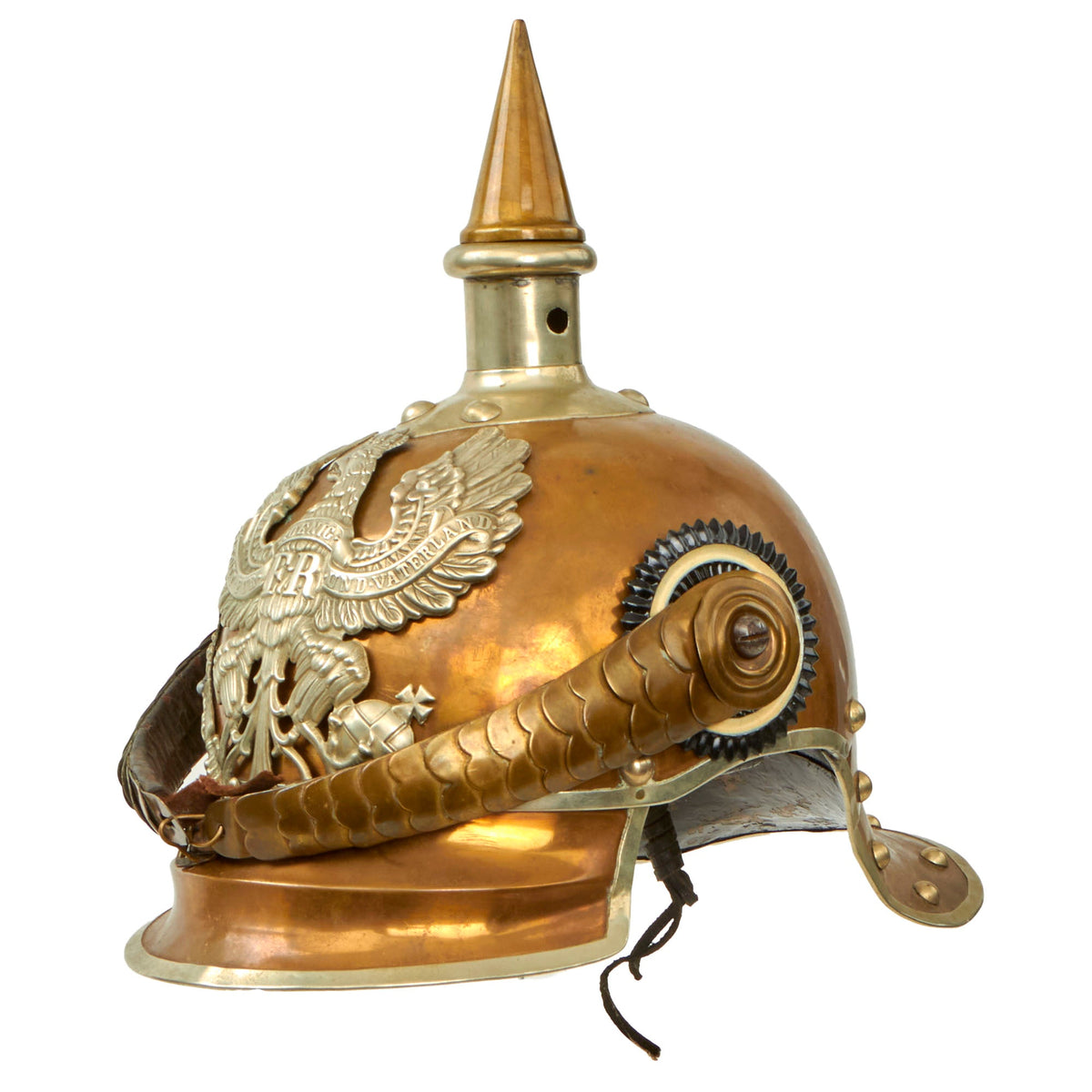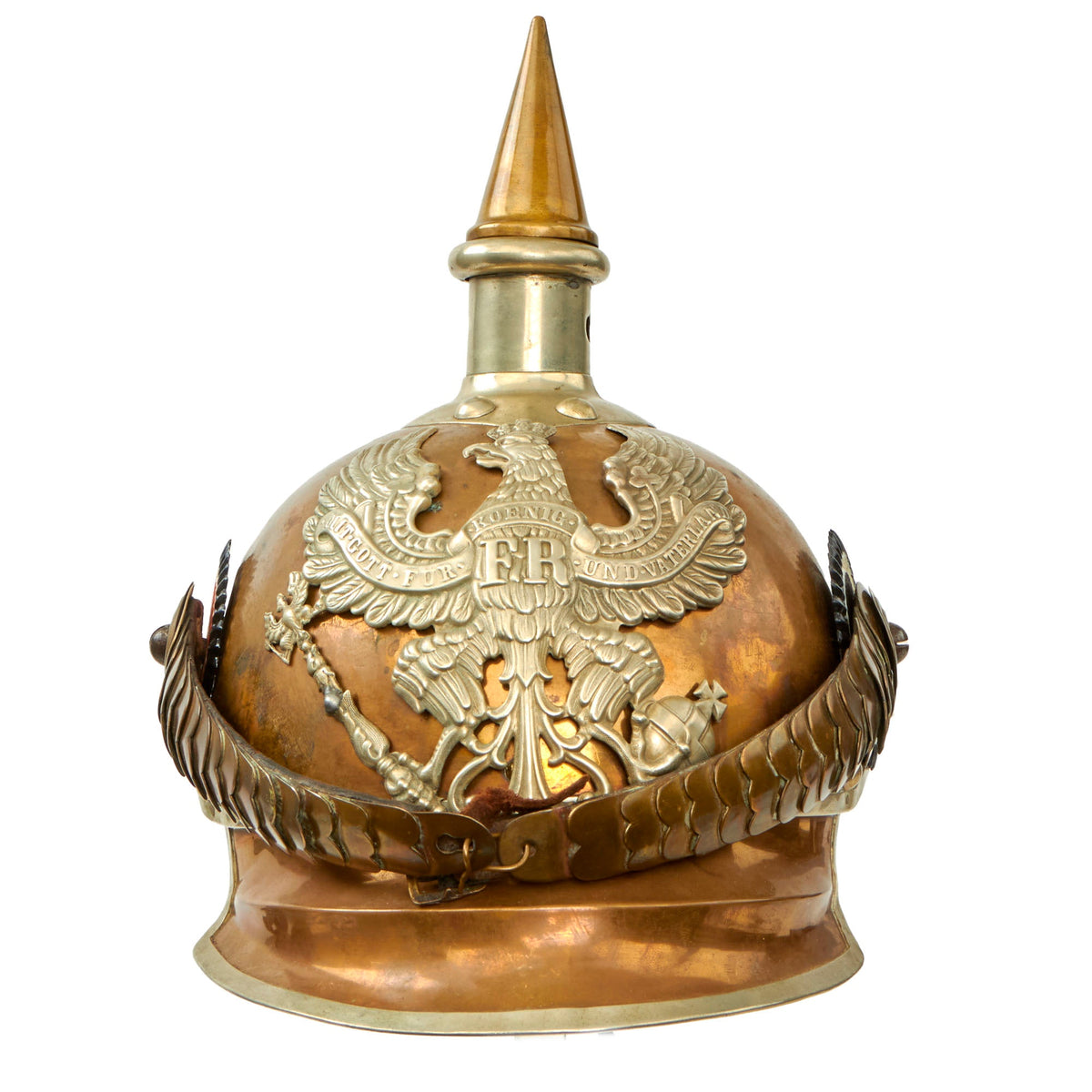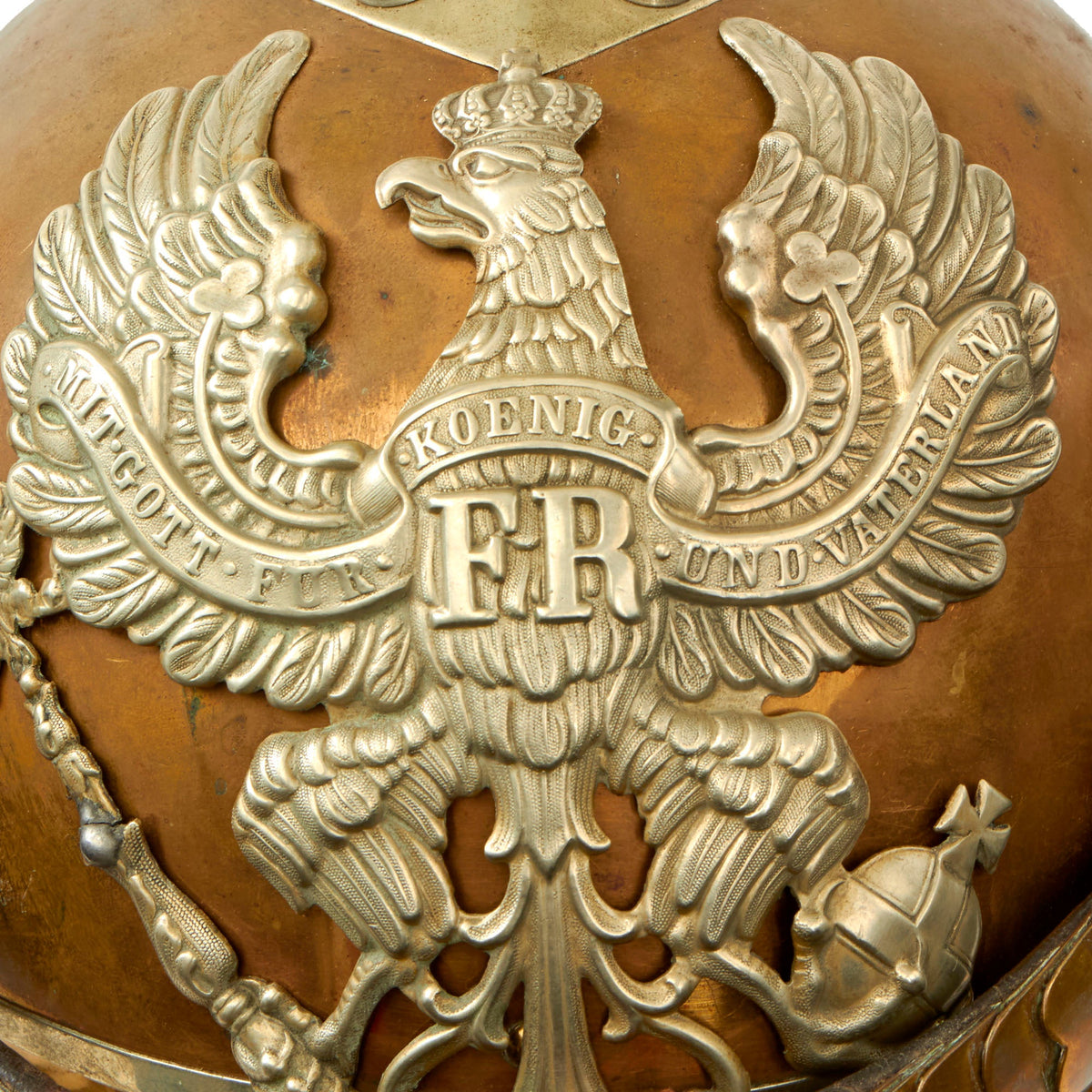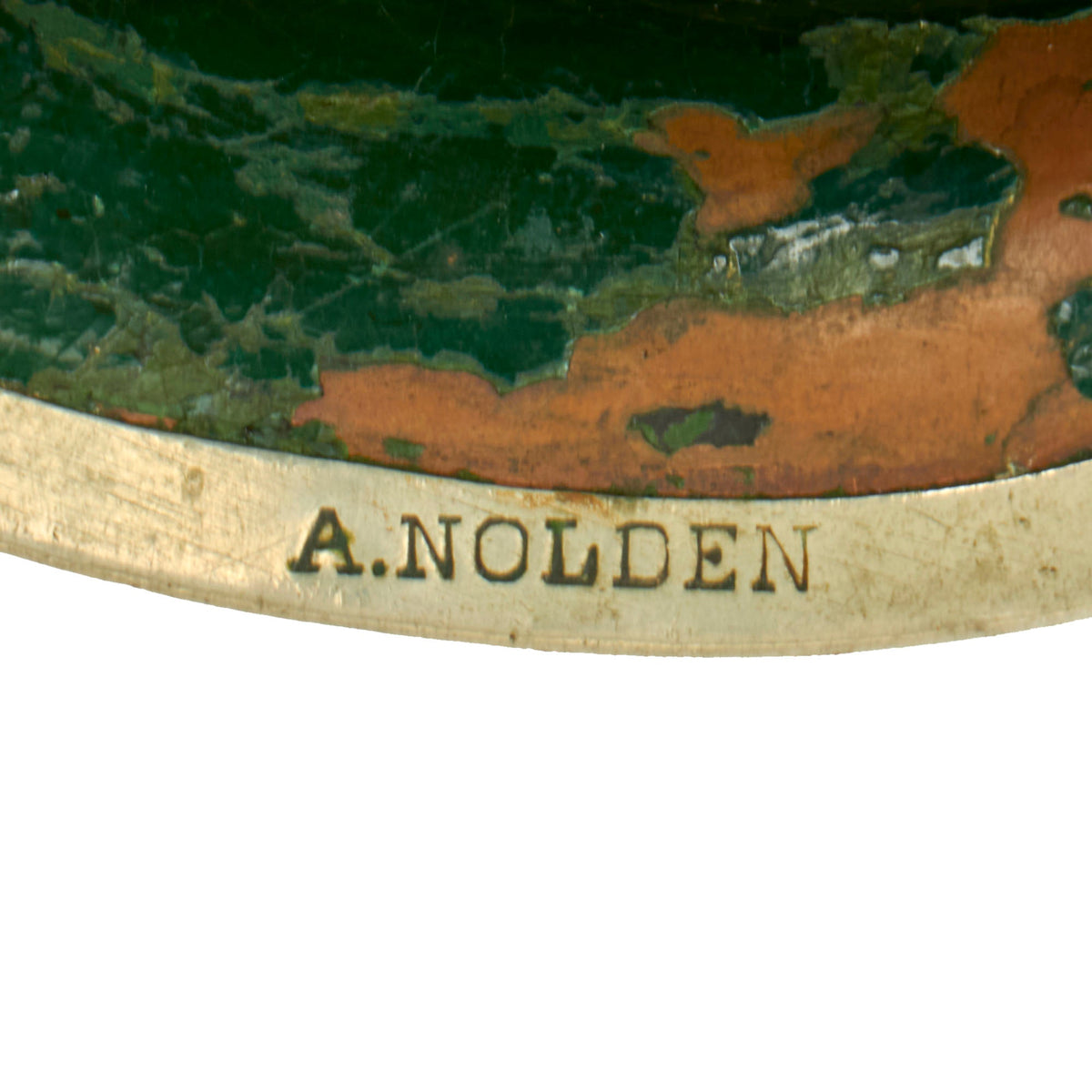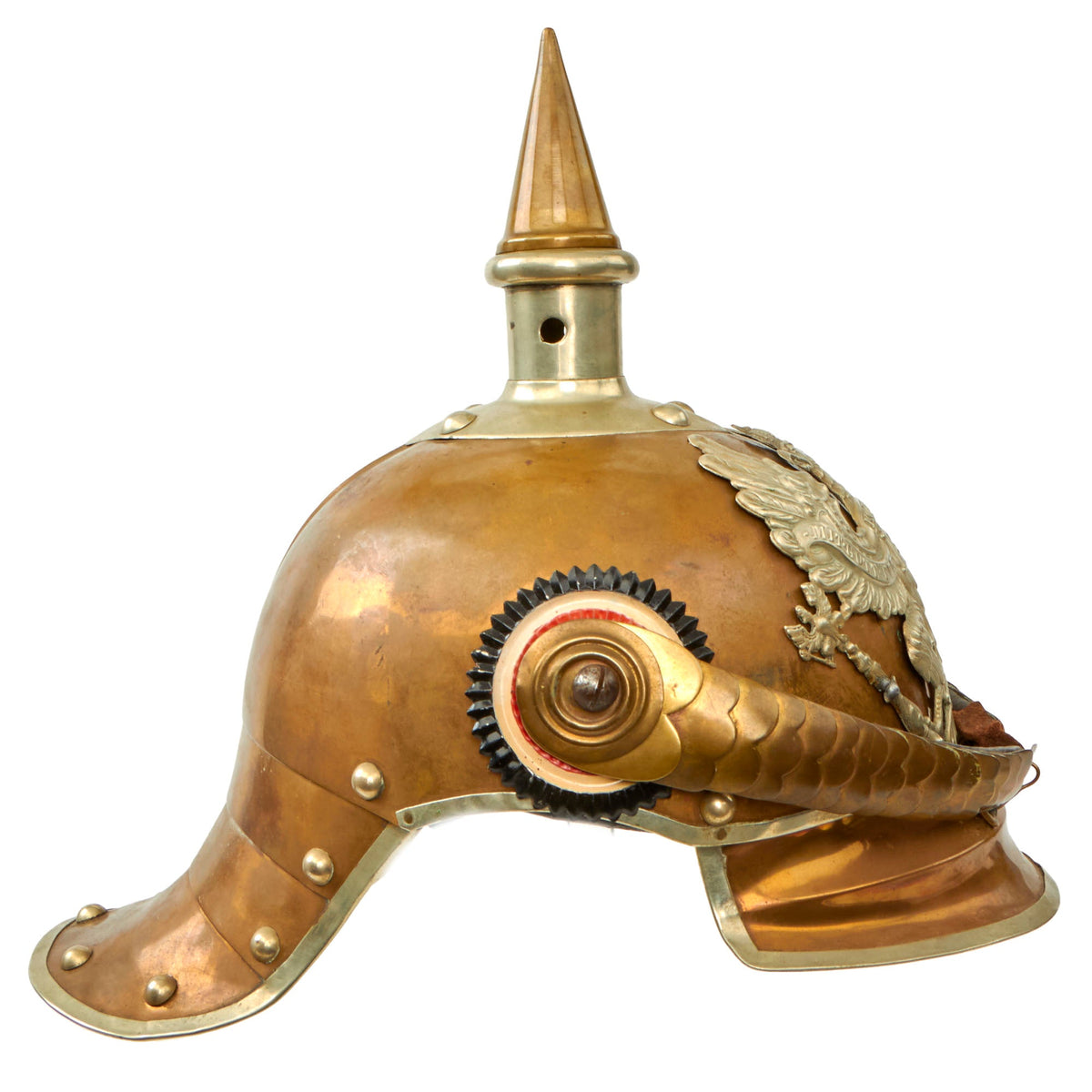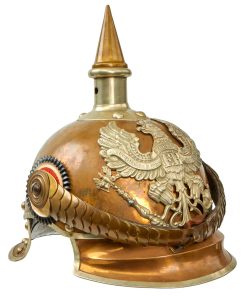Original German Pre-WWI M1862/67 Kurassier Line Regiments Lobster Tail Pickelhaube Spiked Helmet Original Items
$ 3.495,00 $ 873,75
Original Item: Only One Available. This is an exceptionally nice Pre-WWI M1862/67 German-Prussian Kurassier Line Regiments Enlisted Mans Lobster Tail Spiked Helmet. Unfortunately the tag where the Regiment marking would be has long since been missing, making this unable to determine the unit. This “Lobster tail” Pickelhaube has a polished brass body with brass edging and rivets. The brass spike base with a spike is without any faults and the top spike is able to be removed easily. Stamped brass Wappen of a Prussian eagle with “FR” on breast and a banner that reads “Mit Gott Fur Koenig Und Vaterland”, With God for King and Fatherland. The brass chin scales have a leather backing with the leather strap appearing to be complete but fragile.
This is a beautiful example to a Pre WWI Kurassier helmet and comes ready to display in your collections!
Kürassier (Heavy Cavalry) Metalhelme 1843 – 1915
The distinctive steel helmets of the Preußen Kürassier and the Sachsen (Saxon) Schweres Reiter first appeared in 1843 for the Preußen Kürassier, replacing the tall leather helmet that was worn up to that time. The M1843 Metalhelme (a helmet made from polished steel or Tombak) was large and heavy with a pronounced stepped-brim over the forehead and a distinctive “lobster tail” neck guard, both of which served to protect the wearer from sword blows.
The helmets were made from polished steel with brass fittings, or Tombak with German silver fittings. Convex brass chin scales were worn by all ranks and were secured to the helmet with a 3cm threaded bolt with a brass head. The chinscales did not hook together and required the use of the small leather strap behind the chin scales to keep them together when not worn under the chin.
The line eagle Wappen (front plate) measured 125mm and carried a “FR” on the eagle’s chest for most Regiments, except Leib-Kürassier-Regt. Großer Kurfürst who used the old Brandenburg eagle Wappen.
The majority of Kürassier regiments wore polished steel helmets with gilt fittings. The following Regiments wore Tombak helmets with silver fittings with the exception of the chinscales, which were also Tombak:
-Regt. der Gardes du Corps;
-Garde-Kürassier-Regiment; and
-Kürassier-Regiment Kaiser Nikolas I. von Rußland (Brandenburgisches) Nr.6;
-Kgl.Sächs (Saxon) Garde-Reiter and Kgl.Sächs. Karabiner-Regiment in 1876. Prior to this date, Sachsen (Saxon) Garde-Reiter wore a M1867 leather Raupenhelm.
1853 – 1860
In 1853 the long threaded bolts for securing the chin scales were replaced by threaded screws and the new chinscales hooked together in the center with a small ball and corresponding hole when not worn under the chin. In 1860 a Bandeau was added to the Wappen with the motto “MIT GOTT FÜR KOENIG UND VATERLAND” (With God For King And Fatherland). Older plates that were void of the Bandeau, were modified by having a Bandeau soldered to the front to make the plates comply with the regulations.
From 1843 to 1860 the Garde du Corps and Garde Kürassier wore a large silver Garde pattern Wappen on the helmet, adding the date “1860” in that year.
1862 – 1867
Further modifications in 1862 reduced the Kürassier Metalhelme shell and spike in height by approx. 2 cm, the front and rear visors were reduced somewhat in length, and the width of the trim around the front and rear visors was reduced from 8 mm to 5 mm. These modifications resulted in the M1862 Metalhelme. In 1867 a small strip of brass or German silver dependent upon the Regiment, was placed along the bottom of the helmet joining the front and rear visors and the overall shape of the helmet was reduced slightly in size. This modification became the M1867 Metalhelme.
Like the M1843 Metalhelme, the liner of the issued M1862 Metalhelme was of heavy leather with rounded “fingers” perforated at the ends for a leather or cotton string to adjust the fit. Contrary to some publications, this liner was in use for issue helmets for the entire life of the Metalhelme from 1843 to 1915. The liner was secured at the sides with the posts of the chinscales, and at the front and rear by spilt brads which passed through the liner and the helmet shell.
1889
In 1889 the Preußen Kürassier Mannschaften (Other Ranks) Metalhelme received a rounded front visor and was reduced in height and volume to make it less cumbersome. Like most helmets, this helmet was updated in 1897 with a Reichs Kokarde.
1894/1897
In 1894 the Preußen Kürassier Mannschaften (Other Ranks) Metalhelme received the Model 1891 posts for chinscales to replace the threaded screw-posts. At 36mm, the M91 pattern chinscales on M94 Metalhelme are considerably wider at their widest point compared to standard Artillery, Train, and other Cavalry rounded chinscales which are only 25mm wide at the widest point.
In 1897 all helmets were updated with the new Reich’s Kokarde, worn on the right side of the Metalhelme; and the State Kokarden was moved to the left side of the helmet.
Officer’s wore a cloverleaf spike base with officer Kokarden while the Mannschaften (Other Ranks) wore an oval shaped base with Mannschaften Kokarden. When the Mannschaften helmet changed from a stepped-visors in 1889, officer Metalhelme retained the stepped visor. Officer Metalhelme also have finer edging around the circumference of the helmet, and utilized the “squared finger” liners until 1880 when the internal sweatband and skull-cap came into use.
On 15 May 1899 the shape of the Kürassier officer’s helmet was changed to the final and more elegant appearance with a domed skull and longer neck.
In accordance with the 1915 regulations steel helmets no longer would use brass, silver, or Tombak. Preußen Kürassier (Other Ranks) Metalhelme were steel with grey oxidized steel fittings for all Regiments and the brass or Tombak chinscales were replaced with a M91 leather chinstrap.
From 1843 to 1857 the Kokarde was made of painted leather, or wool. In 1857 the stamped metal Kokarde was introduced which measured an impressive 73 mm. In 1860 the size was reduced to 63 mm, which can be found with both the small-hole (pre-1891) and with the larger hole for the M1891 chinscale mount. Model 1915 Metalhelme are found with both the large 63 mm M1891 Metalhelme Kokarde and the standard M1891 Pickelhaube pattern Kokarde.
Fast Shipping with Professional Packaging
Thanks to our longstanding association with UPS FedEx DHL, and other major international carriers, we are able to provide a range of shipping options. Our warehouse staff is expertly trained and will wrap your products according to our exact and precise specifications. Prior to shipping, your goods will be thoroughly examined and securely secured. We ship to thousands clients each day across multiple countries. This shows how we're dedicated to be the largest retailer on the internet. Warehouses and distribution centres can be located throughout Europe as well as the USA.
Note: Orders with more than one item will be assigned a processing date depending on the item.
Before shipping before shipping, we'll conduct a thorough inspection of the items you have ordered. Today, the majority of orders will be delivered within 48 hours. The delivery time will be between 3-7 days.
Returns
The stock is dynamic and we cannot completely manage it because multiple stakeholders are involved, including our factory and warehouse. So the actual stock may alter at any time. It's possible that you may not receive your order once the order has been made.
Our policy is valid for a period of 30 days. If you don't receive the product within 30 days, we are not able to issue a refund or an exchange.
You can only return an item if it is unused and in the same state as the day you received it. You must have the item in its original packaging.
Related products
Uncategorized
Uncategorized
Uncategorized
Band of Brothers ORIGINAL GERMAN WWII Le. F.H. 18 10.5cm ARTILLERY PIECE Original Items
Uncategorized
Uncategorized
Uncategorized
Uncategorized
Uncategorized
Uncategorized
Uncategorized
Uncategorized
Uncategorized
Uncategorized
Armored Burgonet Helmet & Polearm from Scottish Castle Leith Hall Circa 1700 Original Items
Uncategorized
Uncategorized
Uncategorized
Armoured Fighting Vehicles of the World: AFVs of World War One (Hardcover Book) New Made Items
Uncategorized
Uncategorized
Uncategorized
Uncategorized

